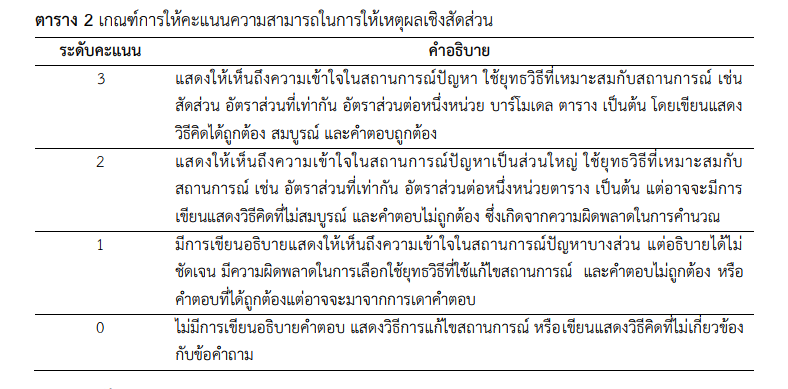The Effects of Using Context-Based Learning Activities for Developing Proportional Reasoning Ability of Mathayomsuksa 1 Students
DOI:
https://doi.org/10.14456/psruhss.2024.23Keywords:
Proportional reasoning, Proportional reasoning ability, Context-based learningAbstract
The objectives of this research were to study proportional reasoning ability during and after using context-based learning activities. The sample consisted of 19 Mathayomsuksa 1 students in academic year 2020 at a school in Bangkok, who were selected using cluster random sampling. The research instruments consisted of lesson plans using context-based learning, a proportional reasoning ability test, and worksheets. The data from a proportional reasoning ability test were analyzed by using descriptive statistics, which are frequency, mean, and percentage, and comparative statistics, one-sample t-test, for testing hypothesis. The data from worksheet were analyzed by using content analysis to summarize the effect of context-based learning activities on proportional reasoning ability during learning through the activities. The results of students’ proportional reasoning ability during the activities showed that students were able to demonstrate strategies for solving a wide range of proportional situations, such as using pictures, tables, rule of three, or using equivalent ratios to find answers. The students expressed understanding the concepts of proportions and proportional situations. The proportional reasoning ability after learning activities showed that the students’ proportional reasoning ability higher than the criteria of 60% at the .05 level of significance the proportional reasoning ability score in aspects of were solving proportion situations of the equivalent ratios with multiplication, comparing ratios, and finding missing value met the criteria of 60%.
References
ขวัญ เพียซ้าย, สุพจน์ ไชยสังข์, ปิยวดี วงษ์ใหญ่, และอรพินท์ เจียระพงษ์. (2553). การพัฒนากิจกรรมการเรียนรู้ที่พัฒนาความสามารถในการให้เหตุผลเชิงสัดส่วนสำหรับนักเรียนชั้นมัธยมศึกษาปีที่ 1 (วิทยานิพนธ์ปริญญาดุษฎีบัณฑิต). กรุงเทพฯ: มหาวิทยาลัยศรีนครินทรวิโรฒ.
ภัทรชา สุขสบาย. (2558). ความสามารถในการนำความรู้เรื่องของไหลไปประยุกต์ใช้ในชีวิตประจำวันและเจตคติต่อการเรียนวิชาฟิสิกส์ของนักเรียนชั้นมัธยมศึกษาปีที่ 5 โดยใช้การจัดการเรียนรู้โดยใช้บริบทเป็นฐาน (วิทยานิพนธ์ปริญญามหาบัณฑิต). กรุงเทพฯ: มหาวิทยาลัยเกษตรศาสตร์.
ยุพาวรรณ คำทา. (2557). การพัฒนาแนวคิดและความสามารถในการนำความรู้เรื่องบรรยากาศไปใช้ในชีวิตประจำวันของนักเรียนชั้นมัธยมศึกษาปีที่ 1 ด้วยการจัดการเรียนรู้โดยใช้บริบทเป็นฐาน (วิทยานิพนธ์ปริญญามหาบัณฑิต). กรุงเทพฯ: มหาวิทยาลัยเกษตรศาสตร์.
รุ่งทิวา บุญมาโตน. (2560). การวิจัยปฏิบัติการเพื่อพัฒนาการรู้เรื่องคณิตศาสตร์ เรื่อง ความน่าจะเป็นของนักเรียนชั้นมัธยมศึกษาปีที่ 5 ด้วยการจัดการเรียนรู้โดยใช้บริบทเป็นฐาน (วิทยานิพนธ์ปริญญามหาบัณฑิต). พิษณุโลก: มหาวิทยาลัยนเรศวร.
ศราวุธ จอมนำ. (2557). ผลการจัดการเรียนรู้โดยใช้บริบทเป็นฐาน เรื่อง อัตราส่วนและร้อยละที่มีต่อผลสัมฤทธิ์ทางการเรียนวิชาคณิตศาสตร์ ความสามารถในการคิดอย่างมีวิจารณญาณและคุณลักษณะใฝ่เรียนรู้ของนักเรียนชั้นมัธยมศึกษาปีที่ 2 (วิทยานิพนธ์ปริญญามหาบัณฑิต). กรุงเทพฯ: มหาวิทยาลัยศรีนครินทรวิโรฒ.
สถาบันส่งเสริมการสอนวิทยาศาสตร์และเทคโนโลยี. (2560). คู่มือการใช้หลักสูตร กลุ่มสาระการเรียนรู้คณิตศาสตร์ (ฉบับปรับปรุง พ.ศ. 2560). กรุงเทพฯ: โรงพิมพ์ชุมนุมสหกรณ์การเกษตรแห่งประเทศไทย.
สถาบันส่งเสริมการสอนวิทยาศาสตร์และเทคโนโลยี. (2563). PISA 2021 กับการประเมินความฉลาดรู้ด้านคณิตศาสตร์. สืบค้น 10 มิถุนายน 2564, จาก https://pisathailand.ipst.ac.th/issue-2020-53/
Artut, P. D., & Pelen, M. S. (2015). 6th grade students’ solution strategies on proportional reasoning problems. Procedia-Social and Behavioral Sciences, 197, 113-119. doi: 10.1016/j.sbspro.2015.07.066
Bennett, J. (2004). Teaching and Learning Science: A guide to recent research and its applications. London: Continuum.
Hillen, A. F. (2005). Examining preservice secondary mathematics teachers' ability to reason proportionally prior to and upon completion of a practice-based mathematics methods course focused on proportional reasoning (Doctoral dissertation). University of Pittsburgh.
Hilton, A., Hilton, G., Dole, S., Goos, M., & O'Brien, M. B. (2012). Evaluating midlle years students’ proportion reasoning. Conference: 35th Annual Conference of the Mathematics Education Research Group of Australasia At: Singapore Volume: Mathematics education: Expanding horizons (Proceedings of the 35th Annual conference of the Mathematics Education Research Group of Australasia, 330-337). Singapore: MERGA.
Hoover, S. (2012). Developing real-world math through literacy. Ohio Journal of School Mathematics, 65(11), 24-29.
Larson, K. (2013). Developing children’s proportional reasoning: Instructional strategies that go the distance. Ohio Journal of School Mathematics, 67, 42-47.
Nasir, R. (2018). Identifying the Students’ Proportional Reasoning. International Journal of Education Science and Research (IJSER), 8(2), 71-78.

Downloads
Published
How to Cite
Issue
Section
License
Copyright (c) 2024 Humanities and Social Sciences Journal of Pibulsongkram Rajabhat University

This work is licensed under a Creative Commons Attribution-NonCommercial-NoDerivatives 4.0 International License.
Any articles or comments appearing in the Journal of Humanities and Social Sciences, Rajabhat Phibulsongkram University, are the intellectual property of the authors, and do not necessarily reflect the views of the editorial board. Published articles are copyrighted by the Journal of Humanities and Social Sciences, Rajabhat Phibulsongkram University.








